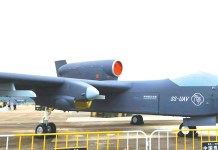The US is contemplating to deploy Aegis Ballistic Missile Defence System in Guam to protect the island from a Chinese attack. The island is vital for US operations in the Pacific and must be protected at all costs, according to US defence experts.
The United States is planning to deploy the deadly Aegis Ballistic Missile Defence System in Guam in preparation of an attack with China. As Sino-American tensions continue to escalate, experts suspect that the island of Guam could be targeted by Beijing.
Phil Davidson, the US Navy admiral in charge of Indo-Pacific Command was the latest to voice his concern. He says that an attack by Chinese could remove from the map the U.S. Air Force’s main Pacific base for bombers and other heavy warplanes.
To protect the US base in Guam, the US should deploy the Aegis missile-defence system on Guam., he says. Aegis Ashore could function as “the backbone of [a] homeland defence system” for the territory, Davidson told reporters on Wednesday.
Guam lies 1,800 miles from China in the middle of the Pacific Ocean. It’s close enough from the Asian mainland to function as a base for bombers, tankers and intelligence aircraft, but far enough to be a tough target for all but the most sophisticated attackers.
The unincorporated territory is also home to the Anderson Air Base. Its long runways and extensive aprons could accommodate hundreds of aircraft. Chinese military planners are well aware of the base’s value to the United States. They’ve spent decades devising means to attack it.
Attack on Guam
According to David Axe, in case of war breaks out between China and the United States, Beijing could hit Guam with 2,500-mile-range DF-26 ballistic missiles, 900-mile CJ-10 cruise missiles from the H-6 bombers and the YJ-18 cruise missiles from the People’s Liberation Army Navy’s ships.
While the launchers of these missiles are all vulnerable to attack during a war, the US suspects a few missiles could definitely hit Guam. Thousands of American lives, billions of dollars worth of warplanes and a key U.S. military advantage—its long-range airpower—could be at risk.
To protect its interests, the US has already deployed the Terminal High-Altitude Air-Defense (THAAD) missile-launchers on Guam and could even deploy the Patriot Advanced Capability-3 missile.
Both THAAD and Patriot are terminal defences. They aim at missiles in the final moments of their flight. The SM-3 is a mid-course defence. It strikes ballistic missiles farther away in the middle of their flight when they’re at the edge of the atmosphere.
There are two ways to launch an SM-3. Pack it into a vertical launch cell on one of the U.S. Navy’s scores of ballistic-missile-defence-capable Aegis destroyers or cruisers or fire it from an installation on land.
Since the extent of Chinese ammunitions arsenal remains unknown, the addition of Aegis Ashore site on Guam makes the perfect sense. The advantage of Aegis Ashore is that it’s cheaper than a destroyer is for a given amount of missile-defence coverage.
The U.S. Pacific Fleet usually deploys around nine destroyers in the western Pacific. The fleet opposes devoting these ships to missile-defence patrols. The fleet already keeps four destroyers in Europe so that one or two can be on station in the event Iran lobs a ballistic missile in a westerly direction.
Those ships can’t really do anything else except steam in a circle … and wait. “You have to be in a tiny little box to have a chance at intercepting that incoming missile,” Adm. John Richardson, then the chief of naval operations, said in 2018.
While Richardson and Davidson agree, the final decision to station the missiles defence system in Guam will be decided by the US Congress.




